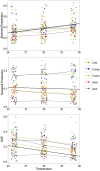Potential changes in bacterial metabolism associated with increased water temperature and nutrient inputs in tropical humic lagoons
- PMID: 25926827
- PMCID: PMC4397971
- DOI: 10.3389/fmicb.2015.00310
Potential changes in bacterial metabolism associated with increased water temperature and nutrient inputs in tropical humic lagoons
Abstract
Temperature and nutrient concentrations regulate aquatic bacterial metabolism. However, few studies have focused on the effect of the interaction between these factors on bacterial processes, and none have been performed in tropical aquatic ecosystems. We analyzed the main and interactive effects of changes in water temperature and N and P concentrations on bacterioplankton production (BP), bacterioplankton respiration (BR) and bacterial growth efficiency (BGE) in tropical coastal lagoons. We used a factorial design with three levels of water temperature (25, 30, and 35°C) and four levels of N and/or P additions (Control, N, P, and NP additions) in five tropical humic lagoons. When data for all lagoons were pooled together, a weak interaction was observed between the increase in water temperature and the addition of nutrients. Water temperature alone had the greatest impact on bacterial metabolism by increasing BR, decreasing BP, and decreasing BGE. An increase of 1°C lead to an increase of ~4% in BR, a decrease of ~0.9% in BP, and a decrease of ~4% in BGE. When data were analyzed separately, lagoons responded differently to nutrient additions depending on Dissolved Organic Carbon (DOC) concentration. Lagoons with lowest DOC concentrations showed the strongest responses to nutrient additions: BP increased in response to N, P, and their interaction, BR increased in response to N and the interaction between N and P, and BGE was negatively affected, mainly by the interaction between N and P additions. Lagoons with the highest DOC concentrations showed almost no significant relationship with nutrient additions. Taken together, these results show that different environmental drivers impact bacterial processes at different scales. Changes of bacterial metabolism related to the increase of water temperature are consistent between lagoons, therefore their consequences can be predicted at a regional scale, while the effect of nutrient inputs is specific to different lagoons but seems to be related to the DOC concentration.
Keywords: bacterial growth efficiency; bacterial metabolism; coastal lagoons; environmental changes; tropical aquatic ecosystems; water temperature.
Figures


References
-
- Bertoni R., Callieri C., Balseiro E., Modenutti B. (2008). Susceptibility of bacterioplankton to nutrient enrichment of oligotrophic and ultraoligotrophic lake waters. J. Limnol. 67 120–127 10.4081/jlimnol.2008.120 - DOI
-
- Borges A. C., Sanders C. J., Santos H. L. R., Araripe D. R., Machado W., Patchineelam S. R. (2009). Eutrophication history of Guanabara Bay (SE Brazil) recorded by phosphorus flux to sediments from a degraded mangrove area. Mar. Poll. Bull. 58 1739–1765 10.1016/j.marpolbul.2009.07.025 - DOI - PubMed
LinkOut - more resources
Full Text Sources
Other Literature Sources
Miscellaneous

